Financial Analysis
VerifiedAdded on 2023/04/21
|22
|4552
|493
AI Summary
This report provides a financial analysis of two investment proposals for AYR Co. The analysis includes net present value, internal rate of return, and payback period calculations. Based on the findings, the Project Aspire is recommended due to its higher net present value and internal rate of return.
Contribute Materials
Your contribution can guide someone’s learning journey. Share your
documents today.

Running Head: FINANCIAL ANALYSIS 0
FINANCIAL ANALYSIS
FINANCIAL ANALYSIS
Secure Best Marks with AI Grader
Need help grading? Try our AI Grader for instant feedback on your assignments.
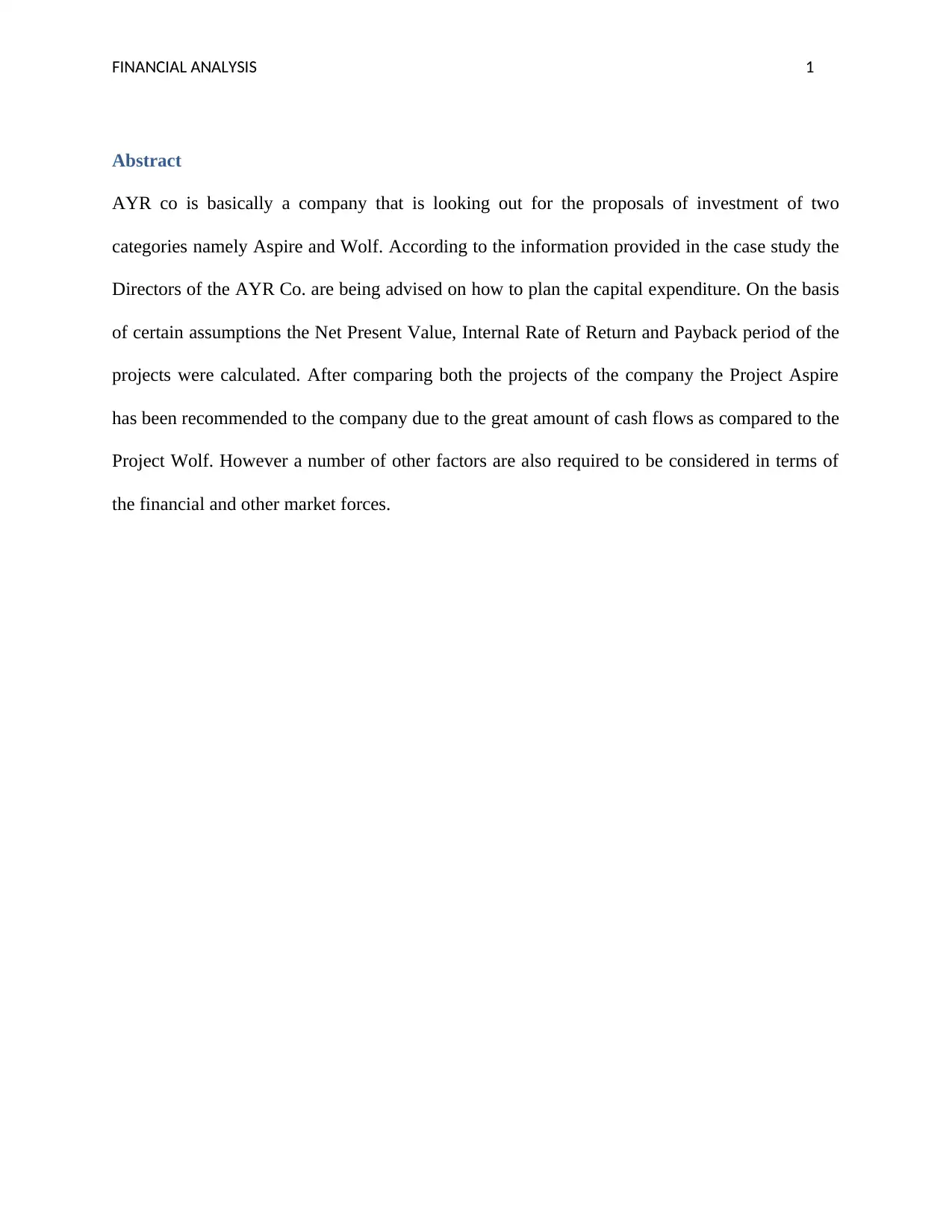
FINANCIAL ANALYSIS 1
Abstract
AYR co is basically a company that is looking out for the proposals of investment of two
categories namely Aspire and Wolf. According to the information provided in the case study the
Directors of the AYR Co. are being advised on how to plan the capital expenditure. On the basis
of certain assumptions the Net Present Value, Internal Rate of Return and Payback period of the
projects were calculated. After comparing both the projects of the company the Project Aspire
has been recommended to the company due to the great amount of cash flows as compared to the
Project Wolf. However a number of other factors are also required to be considered in terms of
the financial and other market forces.
Abstract
AYR co is basically a company that is looking out for the proposals of investment of two
categories namely Aspire and Wolf. According to the information provided in the case study the
Directors of the AYR Co. are being advised on how to plan the capital expenditure. On the basis
of certain assumptions the Net Present Value, Internal Rate of Return and Payback period of the
projects were calculated. After comparing both the projects of the company the Project Aspire
has been recommended to the company due to the great amount of cash flows as compared to the
Project Wolf. However a number of other factors are also required to be considered in terms of
the financial and other market forces.
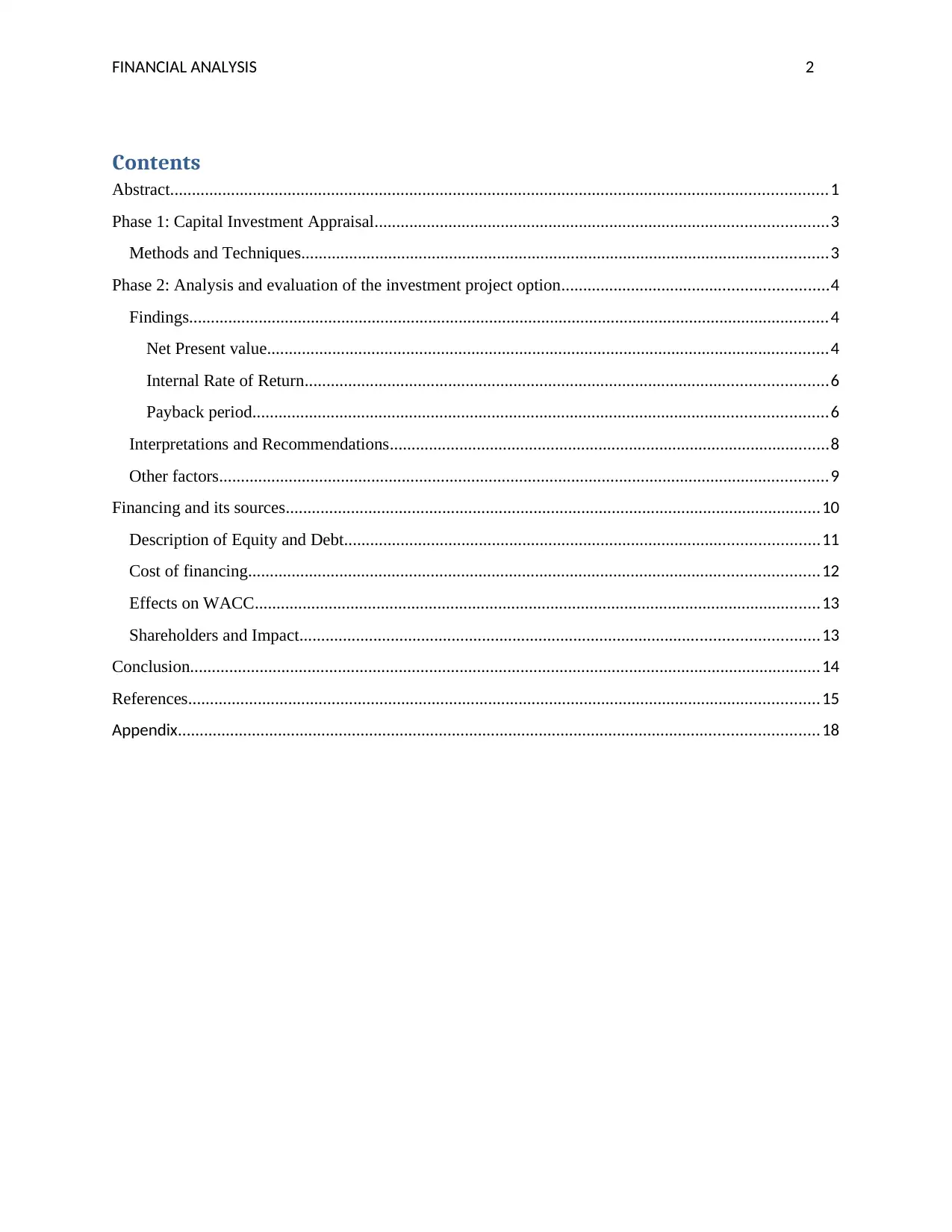
FINANCIAL ANALYSIS 2
Contents
Abstract.......................................................................................................................................................1
Phase 1: Capital Investment Appraisal........................................................................................................3
Methods and Techniques.........................................................................................................................3
Phase 2: Analysis and evaluation of the investment project option.............................................................4
Findings...................................................................................................................................................4
Net Present value.................................................................................................................................4
Internal Rate of Return........................................................................................................................6
Payback period....................................................................................................................................6
Interpretations and Recommendations.....................................................................................................8
Other factors............................................................................................................................................9
Financing and its sources...........................................................................................................................10
Description of Equity and Debt.............................................................................................................11
Cost of financing...................................................................................................................................12
Effects on WACC..................................................................................................................................13
Shareholders and Impact.......................................................................................................................13
Conclusion.................................................................................................................................................14
References.................................................................................................................................................15
Appendix...................................................................................................................................................18
Contents
Abstract.......................................................................................................................................................1
Phase 1: Capital Investment Appraisal........................................................................................................3
Methods and Techniques.........................................................................................................................3
Phase 2: Analysis and evaluation of the investment project option.............................................................4
Findings...................................................................................................................................................4
Net Present value.................................................................................................................................4
Internal Rate of Return........................................................................................................................6
Payback period....................................................................................................................................6
Interpretations and Recommendations.....................................................................................................8
Other factors............................................................................................................................................9
Financing and its sources...........................................................................................................................10
Description of Equity and Debt.............................................................................................................11
Cost of financing...................................................................................................................................12
Effects on WACC..................................................................................................................................13
Shareholders and Impact.......................................................................................................................13
Conclusion.................................................................................................................................................14
References.................................................................................................................................................15
Appendix...................................................................................................................................................18

FINANCIAL ANALYSIS 3
Phase 1: Capital Investment Appraisal
The capital investment appraisal is a segment of the planning which assist in evaluating the long
terms investments or the short term investment. There are various methods to calculate the
viability of the investments and such techniques are namely IRR, Net present Value, and
Profitability index. The current report will be restricted to these three methods an these
techniques are used to determine the future prospects that will be beneficial after the
implementation. In order to increase the market share the AYR Co shall focus on the ability of
the projects to generate enough cash flows (Caselli and Negri, 2018).
Methods and Techniques
As mentioned in the report the three methods of the appraisal and capital investments include the
net present value, the IRR and the payback period. The first two methods also consider the
concept of the time value of money (Burns and Walker, 2015).
Net Present value: it is the calculative description of the difference between the inflows and the
outflows of the cash. The net present value is calculated at the discounted rate. The decision on
the basis of the net present value can be considered on the basis of the high or low present value.
The higher the net present value, the desirability of the project increases accordingly (Rad,
Jamili, Tavakkoli-Moghaddam and Paknahad, 2016).
Formula:
NPV = Cashflow - Initial Investment
(1+i)^t
Phase 1: Capital Investment Appraisal
The capital investment appraisal is a segment of the planning which assist in evaluating the long
terms investments or the short term investment. There are various methods to calculate the
viability of the investments and such techniques are namely IRR, Net present Value, and
Profitability index. The current report will be restricted to these three methods an these
techniques are used to determine the future prospects that will be beneficial after the
implementation. In order to increase the market share the AYR Co shall focus on the ability of
the projects to generate enough cash flows (Caselli and Negri, 2018).
Methods and Techniques
As mentioned in the report the three methods of the appraisal and capital investments include the
net present value, the IRR and the payback period. The first two methods also consider the
concept of the time value of money (Burns and Walker, 2015).
Net Present value: it is the calculative description of the difference between the inflows and the
outflows of the cash. The net present value is calculated at the discounted rate. The decision on
the basis of the net present value can be considered on the basis of the high or low present value.
The higher the net present value, the desirability of the project increases accordingly (Rad,
Jamili, Tavakkoli-Moghaddam and Paknahad, 2016).
Formula:
NPV = Cashflow - Initial Investment
(1+i)^t
Secure Best Marks with AI Grader
Need help grading? Try our AI Grader for instant feedback on your assignments.
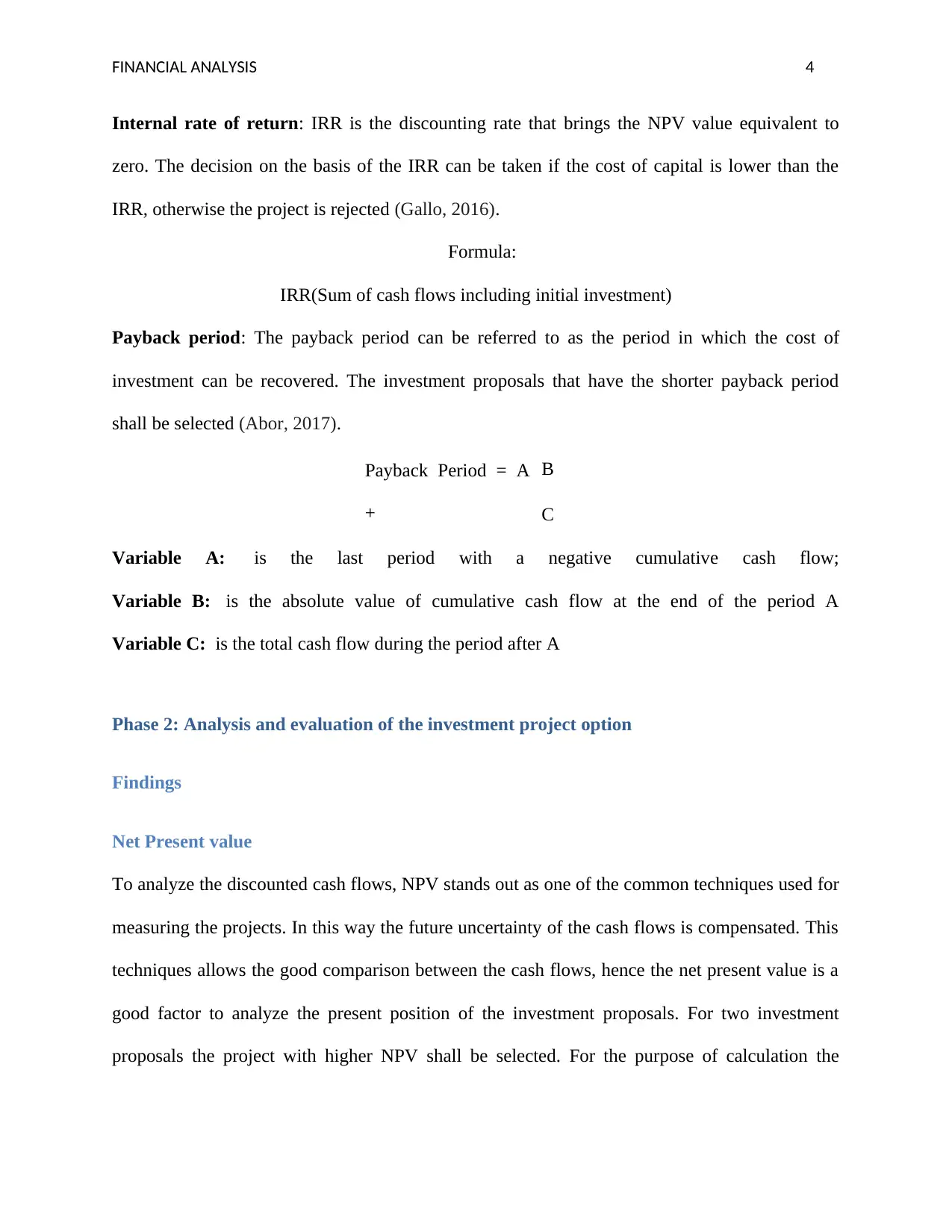
FINANCIAL ANALYSIS 4
Internal rate of return: IRR is the discounting rate that brings the NPV value equivalent to
zero. The decision on the basis of the IRR can be taken if the cost of capital is lower than the
IRR, otherwise the project is rejected (Gallo, 2016).
Formula:
IRR(Sum of cash flows including initial investment)
Payback period: The payback period can be referred to as the period in which the cost of
investment can be recovered. The investment proposals that have the shorter payback period
shall be selected (Abor, 2017).
Payback Period = A
+
B
C
Variable A: is the last period with a negative cumulative cash flow;
Variable B: is the absolute value of cumulative cash flow at the end of the period A
Variable C: is the total cash flow during the period after A
Phase 2: Analysis and evaluation of the investment project option
Findings
Net Present value
To analyze the discounted cash flows, NPV stands out as one of the common techniques used for
measuring the projects. In this way the future uncertainty of the cash flows is compensated. This
techniques allows the good comparison between the cash flows, hence the net present value is a
good factor to analyze the present position of the investment proposals. For two investment
proposals the project with higher NPV shall be selected. For the purpose of calculation the
Internal rate of return: IRR is the discounting rate that brings the NPV value equivalent to
zero. The decision on the basis of the IRR can be taken if the cost of capital is lower than the
IRR, otherwise the project is rejected (Gallo, 2016).
Formula:
IRR(Sum of cash flows including initial investment)
Payback period: The payback period can be referred to as the period in which the cost of
investment can be recovered. The investment proposals that have the shorter payback period
shall be selected (Abor, 2017).
Payback Period = A
+
B
C
Variable A: is the last period with a negative cumulative cash flow;
Variable B: is the absolute value of cumulative cash flow at the end of the period A
Variable C: is the total cash flow during the period after A
Phase 2: Analysis and evaluation of the investment project option
Findings
Net Present value
To analyze the discounted cash flows, NPV stands out as one of the common techniques used for
measuring the projects. In this way the future uncertainty of the cash flows is compensated. This
techniques allows the good comparison between the cash flows, hence the net present value is a
good factor to analyze the present position of the investment proposals. For two investment
proposals the project with higher NPV shall be selected. For the purpose of calculation the

FINANCIAL ANALYSIS 5
discounted rate of 10% is used to discount all the net cash flows to their present value. The same
can be observed with the help of the table (Leyman and Vanhoucke, 2016).
Project Aspire
Calculation of
Net present
Value
Years Cash
flows
Discounting
Factor @
10%
NPV
0 -2250000 1.00
-
2250000
1 623000 0.91 566930
2 665328 0.83 552222
3 664403 0.75 498302
4 699570 0.68 475708
5 1113063 0.62 690099
6 -193599 0.56 -108415
Net Present
Value 424846
Project Wolf
Calculation of Net
present Value
Years Cash
flows
Discountin
g Factor @
10%
NPV
0
-
225000
0 1.00
-
225000
0
1 847600 0.91 771316
2 678350 0.83 563031
3 678384 0.75 508788
4 678273 0.68 461226
5 678019 0.62 420372
6
-
169518 0.56 -94930
Net Present Value 379801
discounted rate of 10% is used to discount all the net cash flows to their present value. The same
can be observed with the help of the table (Leyman and Vanhoucke, 2016).
Project Aspire
Calculation of
Net present
Value
Years Cash
flows
Discounting
Factor @
10%
NPV
0 -2250000 1.00
-
2250000
1 623000 0.91 566930
2 665328 0.83 552222
3 664403 0.75 498302
4 699570 0.68 475708
5 1113063 0.62 690099
6 -193599 0.56 -108415
Net Present
Value 424846
Project Wolf
Calculation of Net
present Value
Years Cash
flows
Discountin
g Factor @
10%
NPV
0
-
225000
0 1.00
-
225000
0
1 847600 0.91 771316
2 678350 0.83 563031
3 678384 0.75 508788
4 678273 0.68 461226
5 678019 0.62 420372
6
-
169518 0.56 -94930
Net Present Value 379801

FINANCIAL ANALYSIS 6
From the above analysis it can be found out that the net present value of the Project Aspire is
better than the net present value of the Project Wolf. But this single factor lone cannot help in
deciding whether the project shall be accepted or rejected or not. The other factors must also be
considered to determine which proposal shall be included.
Internal Rate of Return
The internal rate of return is the accounting rate which is basically achieved when the project is
at breakeven. The investors invest in the project on the basis of the internal rate of return because
this rate reflects what amount in return the investor is going to get. The decision to choose the
investment is based upon IRR greater the cost of capital. The higher the IRR the more attractive
the project is. In order to calculate the IRR the following method can be used to present the IRR
(Bornholt, 2017).
Calculati
on of
IRR
Cash
flows
(Aspir
e)
Cash
flows
(Wolf)
-
22500
00
-
22500
00
62300
0
84760
0
66532
8
67835
0
66440
3
67838
4
69957
0
67827
3
11130
63
67801
9
- -
From the above analysis it can be found out that the net present value of the Project Aspire is
better than the net present value of the Project Wolf. But this single factor lone cannot help in
deciding whether the project shall be accepted or rejected or not. The other factors must also be
considered to determine which proposal shall be included.
Internal Rate of Return
The internal rate of return is the accounting rate which is basically achieved when the project is
at breakeven. The investors invest in the project on the basis of the internal rate of return because
this rate reflects what amount in return the investor is going to get. The decision to choose the
investment is based upon IRR greater the cost of capital. The higher the IRR the more attractive
the project is. In order to calculate the IRR the following method can be used to present the IRR
(Bornholt, 2017).
Calculati
on of
IRR
Cash
flows
(Aspir
e)
Cash
flows
(Wolf)
-
22500
00
-
22500
00
62300
0
84760
0
66532
8
67835
0
66440
3
67838
4
69957
0
67827
3
11130
63
67801
9
- -
Paraphrase This Document
Need a fresh take? Get an instant paraphrase of this document with our AI Paraphraser
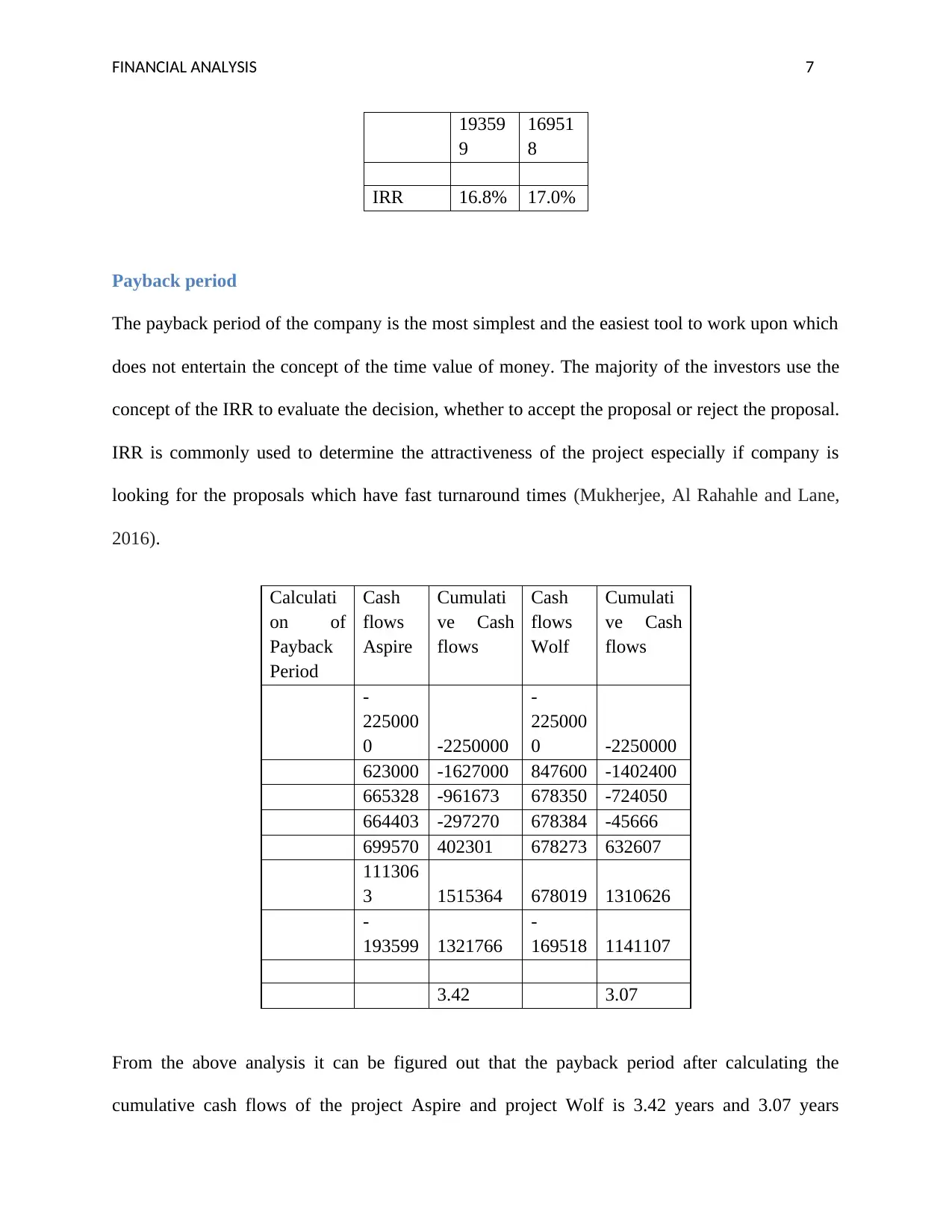
FINANCIAL ANALYSIS 7
19359
9
16951
8
IRR 16.8% 17.0%
Payback period
The payback period of the company is the most simplest and the easiest tool to work upon which
does not entertain the concept of the time value of money. The majority of the investors use the
concept of the IRR to evaluate the decision, whether to accept the proposal or reject the proposal.
IRR is commonly used to determine the attractiveness of the project especially if company is
looking for the proposals which have fast turnaround times (Mukherjee, Al Rahahle and Lane,
2016).
Calculati
on of
Payback
Period
Cash
flows
Aspire
Cumulati
ve Cash
flows
Cash
flows
Wolf
Cumulati
ve Cash
flows
-
225000
0 -2250000
-
225000
0 -2250000
623000 -1627000 847600 -1402400
665328 -961673 678350 -724050
664403 -297270 678384 -45666
699570 402301 678273 632607
111306
3 1515364 678019 1310626
-
193599 1321766
-
169518 1141107
3.42 3.07
From the above analysis it can be figured out that the payback period after calculating the
cumulative cash flows of the project Aspire and project Wolf is 3.42 years and 3.07 years
19359
9
16951
8
IRR 16.8% 17.0%
Payback period
The payback period of the company is the most simplest and the easiest tool to work upon which
does not entertain the concept of the time value of money. The majority of the investors use the
concept of the IRR to evaluate the decision, whether to accept the proposal or reject the proposal.
IRR is commonly used to determine the attractiveness of the project especially if company is
looking for the proposals which have fast turnaround times (Mukherjee, Al Rahahle and Lane,
2016).
Calculati
on of
Payback
Period
Cash
flows
Aspire
Cumulati
ve Cash
flows
Cash
flows
Wolf
Cumulati
ve Cash
flows
-
225000
0 -2250000
-
225000
0 -2250000
623000 -1627000 847600 -1402400
665328 -961673 678350 -724050
664403 -297270 678384 -45666
699570 402301 678273 632607
111306
3 1515364 678019 1310626
-
193599 1321766
-
169518 1141107
3.42 3.07
From the above analysis it can be figured out that the payback period after calculating the
cumulative cash flows of the project Aspire and project Wolf is 3.42 years and 3.07 years

FINANCIAL ANALYSIS 8
respectively. The Wolf project has more capacity than the Aspire project. This certainly doesn’t
mean that the Aspire project is bad and shall not be selected the Aspire project though is going to
recover the cost a little later yet it can be chosen on the basis of the net present value and internal
rate of return if combined in taking the overall decision (Robinson and Burnett, 2016).
respectively. The Wolf project has more capacity than the Aspire project. This certainly doesn’t
mean that the Aspire project is bad and shall not be selected the Aspire project though is going to
recover the cost a little later yet it can be chosen on the basis of the net present value and internal
rate of return if combined in taking the overall decision (Robinson and Burnett, 2016).
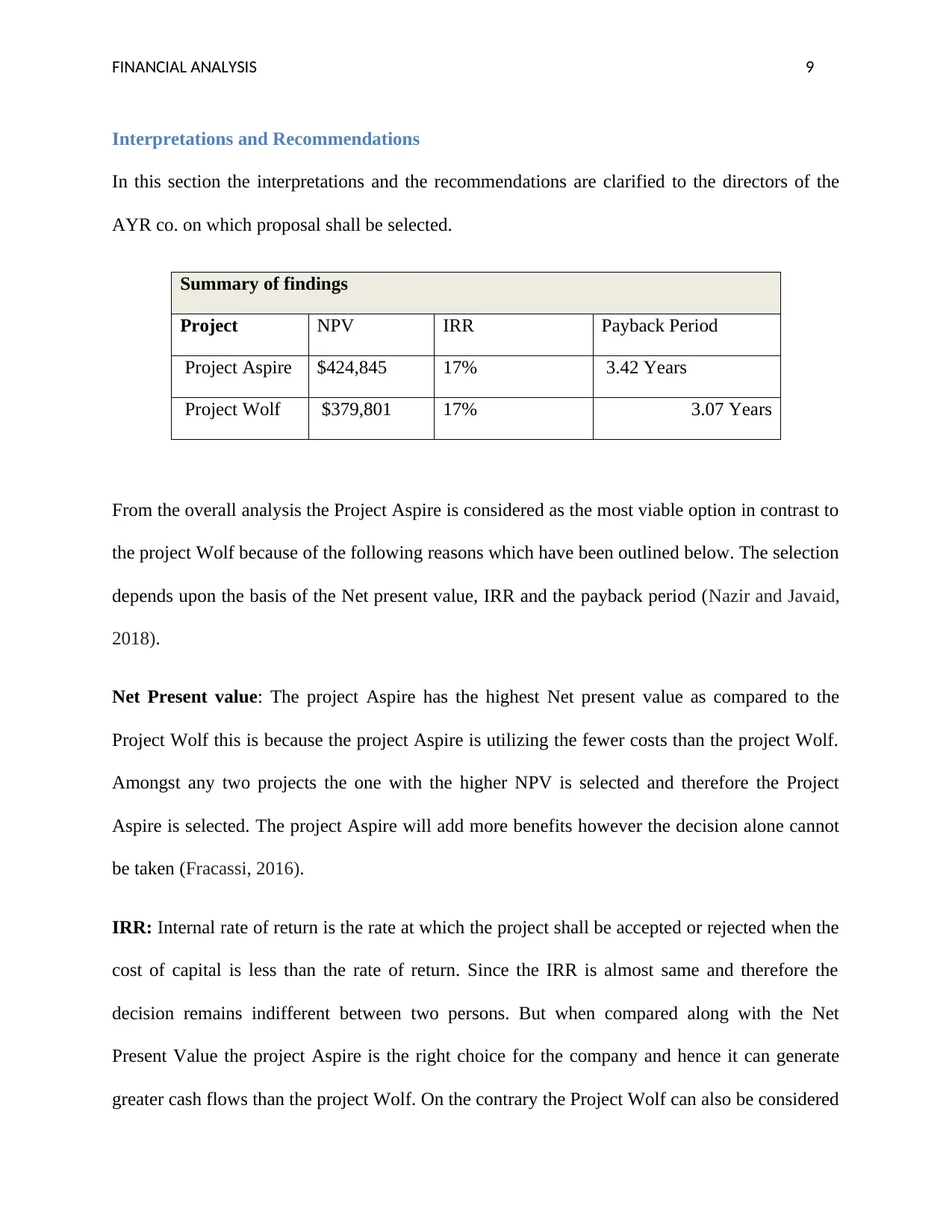
FINANCIAL ANALYSIS 9
Interpretations and Recommendations
In this section the interpretations and the recommendations are clarified to the directors of the
AYR co. on which proposal shall be selected.
Summary of findings
Project NPV IRR Payback Period
Project Aspire $424,845 17% 3.42 Years
Project Wolf $379,801 17% 3.07 Years
From the overall analysis the Project Aspire is considered as the most viable option in contrast to
the project Wolf because of the following reasons which have been outlined below. The selection
depends upon the basis of the Net present value, IRR and the payback period (Nazir and Javaid,
2018).
Net Present value: The project Aspire has the highest Net present value as compared to the
Project Wolf this is because the project Aspire is utilizing the fewer costs than the project Wolf.
Amongst any two projects the one with the higher NPV is selected and therefore the Project
Aspire is selected. The project Aspire will add more benefits however the decision alone cannot
be taken (Fracassi, 2016).
IRR: Internal rate of return is the rate at which the project shall be accepted or rejected when the
cost of capital is less than the rate of return. Since the IRR is almost same and therefore the
decision remains indifferent between two persons. But when compared along with the Net
Present Value the project Aspire is the right choice for the company and hence it can generate
greater cash flows than the project Wolf. On the contrary the Project Wolf can also be considered
Interpretations and Recommendations
In this section the interpretations and the recommendations are clarified to the directors of the
AYR co. on which proposal shall be selected.
Summary of findings
Project NPV IRR Payback Period
Project Aspire $424,845 17% 3.42 Years
Project Wolf $379,801 17% 3.07 Years
From the overall analysis the Project Aspire is considered as the most viable option in contrast to
the project Wolf because of the following reasons which have been outlined below. The selection
depends upon the basis of the Net present value, IRR and the payback period (Nazir and Javaid,
2018).
Net Present value: The project Aspire has the highest Net present value as compared to the
Project Wolf this is because the project Aspire is utilizing the fewer costs than the project Wolf.
Amongst any two projects the one with the higher NPV is selected and therefore the Project
Aspire is selected. The project Aspire will add more benefits however the decision alone cannot
be taken (Fracassi, 2016).
IRR: Internal rate of return is the rate at which the project shall be accepted or rejected when the
cost of capital is less than the rate of return. Since the IRR is almost same and therefore the
decision remains indifferent between two persons. But when compared along with the Net
Present Value the project Aspire is the right choice for the company and hence it can generate
greater cash flows than the project Wolf. On the contrary the Project Wolf can also be considered
Secure Best Marks with AI Grader
Need help grading? Try our AI Grader for instant feedback on your assignments.

FINANCIAL ANALYSIS 10
just on the basis of the IRR and this can also add more value to the AYR Co. hence, overall
conclusion will fall in favor of the Project Aspire only (Ehrhardt and Brigham, 2016).
Payback Period: Lastly in terms of the payback period the Project Wolf is ahead of Project
Aspire as the number of days the investment can recover the cost of investment in 3.07 years
whereas in case of the Aspire project the payback period is 3.42 years. Under this situation the
project Wolf is recommended to the AYR Co. as it will recover the cost of investment in the
faster manner. The project Wolf might be a fruitful one but the Project Aspire is the most
desirable choice in terms of the overall selection of the proposal (Pham and Alenikov, 2018).
Other factors
Strategic options
The strategy plays an important factor determining the selection of the proposal and the
acceptance. This usually occurs when the product breaks the sales of another product. If such
case arises for the Project Aspire it is recommended to the directors of the company to entertain
the Wolf project more as it appeal to the different categories and while the Aspire project is used
to fulfill the expectations of the existing customers. In such a case the desirability of the project
will increase and will be favorable for the company. Such strategies will define the right choice
that fits the resources of the company.
Personnel
Personnel also play a vital role in selection of the proposal and the situations differ accordingly.
In case of the AYR Co. has experts and the skilled people or they have the capacity to enjoy the
wider options in the market. The non-financial factors shall also be considered (Harris, 2018).
just on the basis of the IRR and this can also add more value to the AYR Co. hence, overall
conclusion will fall in favor of the Project Aspire only (Ehrhardt and Brigham, 2016).
Payback Period: Lastly in terms of the payback period the Project Wolf is ahead of Project
Aspire as the number of days the investment can recover the cost of investment in 3.07 years
whereas in case of the Aspire project the payback period is 3.42 years. Under this situation the
project Wolf is recommended to the AYR Co. as it will recover the cost of investment in the
faster manner. The project Wolf might be a fruitful one but the Project Aspire is the most
desirable choice in terms of the overall selection of the proposal (Pham and Alenikov, 2018).
Other factors
Strategic options
The strategy plays an important factor determining the selection of the proposal and the
acceptance. This usually occurs when the product breaks the sales of another product. If such
case arises for the Project Aspire it is recommended to the directors of the company to entertain
the Wolf project more as it appeal to the different categories and while the Aspire project is used
to fulfill the expectations of the existing customers. In such a case the desirability of the project
will increase and will be favorable for the company. Such strategies will define the right choice
that fits the resources of the company.
Personnel
Personnel also play a vital role in selection of the proposal and the situations differ accordingly.
In case of the AYR Co. has experts and the skilled people or they have the capacity to enjoy the
wider options in the market. The non-financial factors shall also be considered (Harris, 2018).
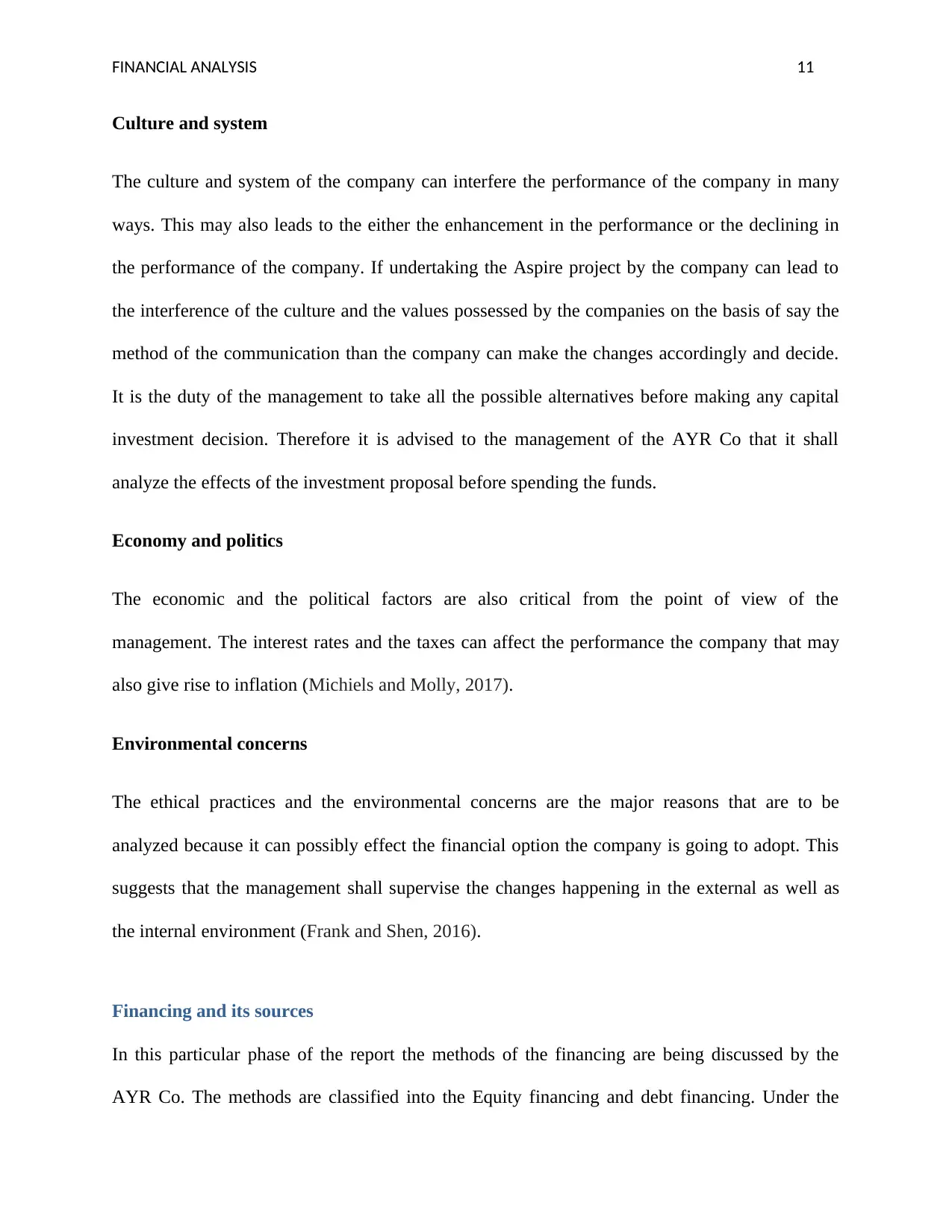
FINANCIAL ANALYSIS 11
Culture and system
The culture and system of the company can interfere the performance of the company in many
ways. This may also leads to the either the enhancement in the performance or the declining in
the performance of the company. If undertaking the Aspire project by the company can lead to
the interference of the culture and the values possessed by the companies on the basis of say the
method of the communication than the company can make the changes accordingly and decide.
It is the duty of the management to take all the possible alternatives before making any capital
investment decision. Therefore it is advised to the management of the AYR Co that it shall
analyze the effects of the investment proposal before spending the funds.
Economy and politics
The economic and the political factors are also critical from the point of view of the
management. The interest rates and the taxes can affect the performance the company that may
also give rise to inflation (Michiels and Molly, 2017).
Environmental concerns
The ethical practices and the environmental concerns are the major reasons that are to be
analyzed because it can possibly effect the financial option the company is going to adopt. This
suggests that the management shall supervise the changes happening in the external as well as
the internal environment (Frank and Shen, 2016).
Financing and its sources
In this particular phase of the report the methods of the financing are being discussed by the
AYR Co. The methods are classified into the Equity financing and debt financing. Under the
Culture and system
The culture and system of the company can interfere the performance of the company in many
ways. This may also leads to the either the enhancement in the performance or the declining in
the performance of the company. If undertaking the Aspire project by the company can lead to
the interference of the culture and the values possessed by the companies on the basis of say the
method of the communication than the company can make the changes accordingly and decide.
It is the duty of the management to take all the possible alternatives before making any capital
investment decision. Therefore it is advised to the management of the AYR Co that it shall
analyze the effects of the investment proposal before spending the funds.
Economy and politics
The economic and the political factors are also critical from the point of view of the
management. The interest rates and the taxes can affect the performance the company that may
also give rise to inflation (Michiels and Molly, 2017).
Environmental concerns
The ethical practices and the environmental concerns are the major reasons that are to be
analyzed because it can possibly effect the financial option the company is going to adopt. This
suggests that the management shall supervise the changes happening in the external as well as
the internal environment (Frank and Shen, 2016).
Financing and its sources
In this particular phase of the report the methods of the financing are being discussed by the
AYR Co. The methods are classified into the Equity financing and debt financing. Under the
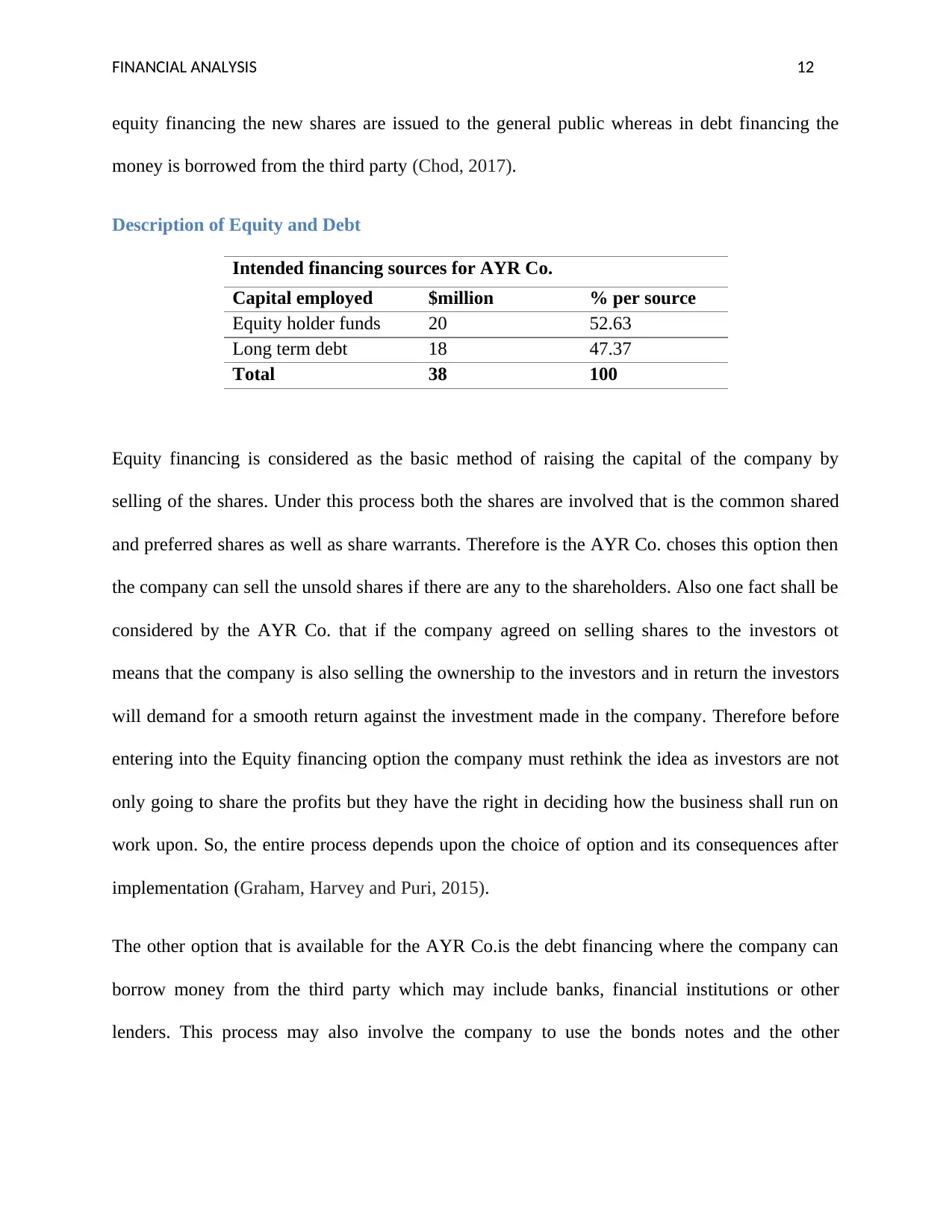
FINANCIAL ANALYSIS 12
equity financing the new shares are issued to the general public whereas in debt financing the
money is borrowed from the third party (Chod, 2017).
Description of Equity and Debt
Intended financing sources for AYR Co.
Capital employed $million % per source
Equity holder funds 20 52.63
Long term debt 18 47.37
Total 38 100
Equity financing is considered as the basic method of raising the capital of the company by
selling of the shares. Under this process both the shares are involved that is the common shared
and preferred shares as well as share warrants. Therefore is the AYR Co. choses this option then
the company can sell the unsold shares if there are any to the shareholders. Also one fact shall be
considered by the AYR Co. that if the company agreed on selling shares to the investors ot
means that the company is also selling the ownership to the investors and in return the investors
will demand for a smooth return against the investment made in the company. Therefore before
entering into the Equity financing option the company must rethink the idea as investors are not
only going to share the profits but they have the right in deciding how the business shall run on
work upon. So, the entire process depends upon the choice of option and its consequences after
implementation (Graham, Harvey and Puri, 2015).
The other option that is available for the AYR Co.is the debt financing where the company can
borrow money from the third party which may include banks, financial institutions or other
lenders. This process may also involve the company to use the bonds notes and the other
equity financing the new shares are issued to the general public whereas in debt financing the
money is borrowed from the third party (Chod, 2017).
Description of Equity and Debt
Intended financing sources for AYR Co.
Capital employed $million % per source
Equity holder funds 20 52.63
Long term debt 18 47.37
Total 38 100
Equity financing is considered as the basic method of raising the capital of the company by
selling of the shares. Under this process both the shares are involved that is the common shared
and preferred shares as well as share warrants. Therefore is the AYR Co. choses this option then
the company can sell the unsold shares if there are any to the shareholders. Also one fact shall be
considered by the AYR Co. that if the company agreed on selling shares to the investors ot
means that the company is also selling the ownership to the investors and in return the investors
will demand for a smooth return against the investment made in the company. Therefore before
entering into the Equity financing option the company must rethink the idea as investors are not
only going to share the profits but they have the right in deciding how the business shall run on
work upon. So, the entire process depends upon the choice of option and its consequences after
implementation (Graham, Harvey and Puri, 2015).
The other option that is available for the AYR Co.is the debt financing where the company can
borrow money from the third party which may include banks, financial institutions or other
lenders. This process may also involve the company to use the bonds notes and the other
Paraphrase This Document
Need a fresh take? Get an instant paraphrase of this document with our AI Paraphraser
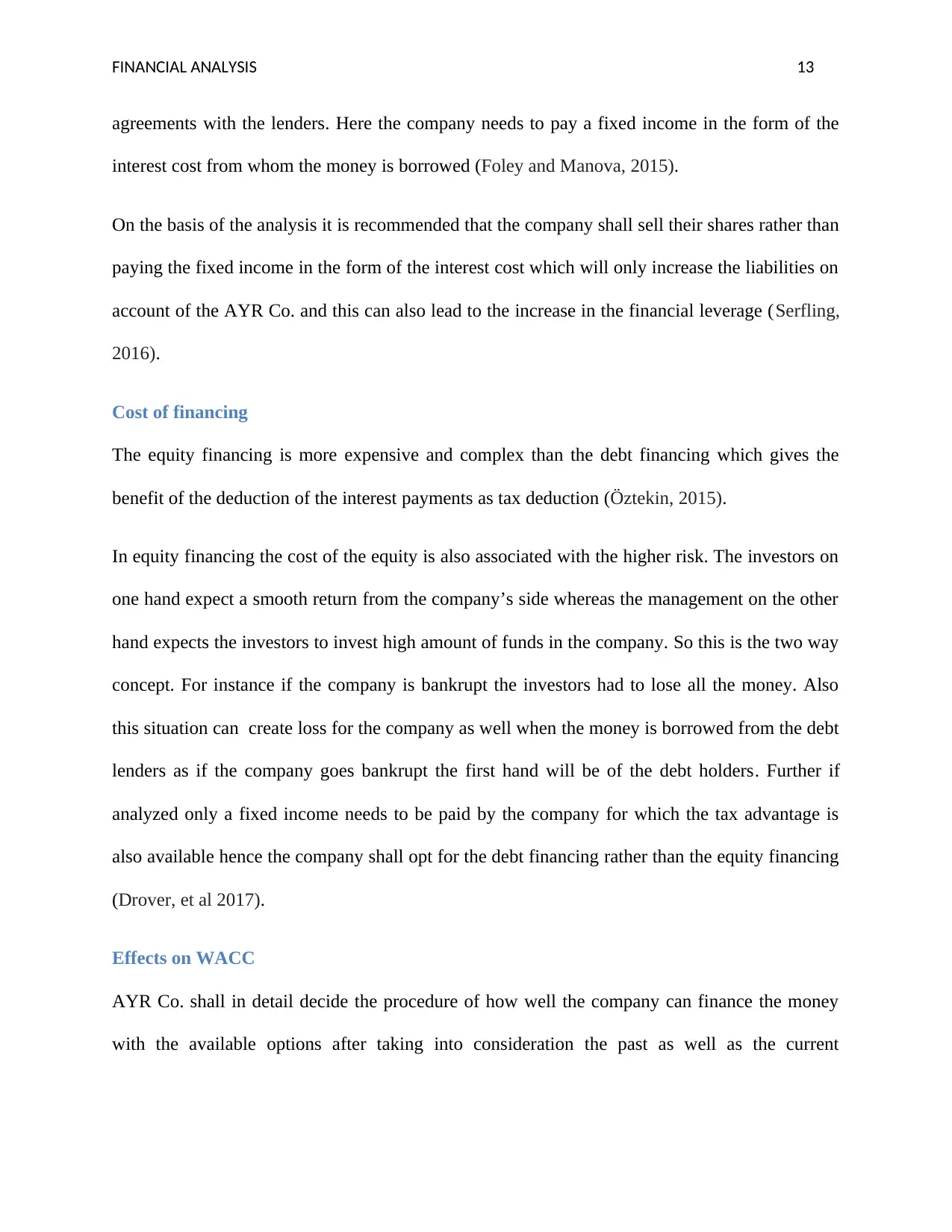
FINANCIAL ANALYSIS 13
agreements with the lenders. Here the company needs to pay a fixed income in the form of the
interest cost from whom the money is borrowed (Foley and Manova, 2015).
On the basis of the analysis it is recommended that the company shall sell their shares rather than
paying the fixed income in the form of the interest cost which will only increase the liabilities on
account of the AYR Co. and this can also lead to the increase in the financial leverage (Serfling,
2016).
Cost of financing
The equity financing is more expensive and complex than the debt financing which gives the
benefit of the deduction of the interest payments as tax deduction (Öztekin, 2015).
In equity financing the cost of the equity is also associated with the higher risk. The investors on
one hand expect a smooth return from the company’s side whereas the management on the other
hand expects the investors to invest high amount of funds in the company. So this is the two way
concept. For instance if the company is bankrupt the investors had to lose all the money. Also
this situation can create loss for the company as well when the money is borrowed from the debt
lenders as if the company goes bankrupt the first hand will be of the debt holders. Further if
analyzed only a fixed income needs to be paid by the company for which the tax advantage is
also available hence the company shall opt for the debt financing rather than the equity financing
(Drover, et al 2017).
Effects on WACC
AYR Co. shall in detail decide the procedure of how well the company can finance the money
with the available options after taking into consideration the past as well as the current
agreements with the lenders. Here the company needs to pay a fixed income in the form of the
interest cost from whom the money is borrowed (Foley and Manova, 2015).
On the basis of the analysis it is recommended that the company shall sell their shares rather than
paying the fixed income in the form of the interest cost which will only increase the liabilities on
account of the AYR Co. and this can also lead to the increase in the financial leverage (Serfling,
2016).
Cost of financing
The equity financing is more expensive and complex than the debt financing which gives the
benefit of the deduction of the interest payments as tax deduction (Öztekin, 2015).
In equity financing the cost of the equity is also associated with the higher risk. The investors on
one hand expect a smooth return from the company’s side whereas the management on the other
hand expects the investors to invest high amount of funds in the company. So this is the two way
concept. For instance if the company is bankrupt the investors had to lose all the money. Also
this situation can create loss for the company as well when the money is borrowed from the debt
lenders as if the company goes bankrupt the first hand will be of the debt holders. Further if
analyzed only a fixed income needs to be paid by the company for which the tax advantage is
also available hence the company shall opt for the debt financing rather than the equity financing
(Drover, et al 2017).
Effects on WACC
AYR Co. shall in detail decide the procedure of how well the company can finance the money
with the available options after taking into consideration the past as well as the current

FINANCIAL ANALYSIS 14
performance of the company. However, whatever choice the company makes it has a direct
effect on the weighted average cost of capital of the company.
The scenario will be such that if the company wants to choose the equity financing the company
may face an increase in the cost of the capital due to increase in share whereas of the debt
financing is the option of the company there may be a reduction in the cost of capital due to the
increased size of the cheapest source. Not only this, AYR Co. shall also analyze the rate of
interest that will directly affect the annual cash flows generated (Klasa, Ortiz-Molina, Serfling
and Srinivasan, 2018).
Shareholders and Impact
There are two major sources of financing, namely the debt and the equity. In general these two
options affect the ownership and the profitability of the business which in fact affects the
shareholders and the investors of the company as well. In case if the equity financing the
shareholders which have the shares at present are diluted if they haven’t purchased any new
shares, whereas in case of the debt financing the liability increase on part of the management as
the fixed amount is kept aside in case of the interest income to be paid to the debenture holders.
Though the process may not have the direct impact on the shareholders yet it touches the overall
concept of the liability (Miller and Skinner, 2015).
Conclusion
From the overall analysis the investment proposal that shall be selected is the Aspire one in
contrast to the Wolf project. The following reasons were mentioned above and discussed in
detail however the Aspire showcased its best ability to fit within the requirements of the AYR
Co. The project has the real ability to pay back the proposal within the time period given.
performance of the company. However, whatever choice the company makes it has a direct
effect on the weighted average cost of capital of the company.
The scenario will be such that if the company wants to choose the equity financing the company
may face an increase in the cost of the capital due to increase in share whereas of the debt
financing is the option of the company there may be a reduction in the cost of capital due to the
increased size of the cheapest source. Not only this, AYR Co. shall also analyze the rate of
interest that will directly affect the annual cash flows generated (Klasa, Ortiz-Molina, Serfling
and Srinivasan, 2018).
Shareholders and Impact
There are two major sources of financing, namely the debt and the equity. In general these two
options affect the ownership and the profitability of the business which in fact affects the
shareholders and the investors of the company as well. In case if the equity financing the
shareholders which have the shares at present are diluted if they haven’t purchased any new
shares, whereas in case of the debt financing the liability increase on part of the management as
the fixed amount is kept aside in case of the interest income to be paid to the debenture holders.
Though the process may not have the direct impact on the shareholders yet it touches the overall
concept of the liability (Miller and Skinner, 2015).
Conclusion
From the overall analysis the investment proposal that shall be selected is the Aspire one in
contrast to the Wolf project. The following reasons were mentioned above and discussed in
detail however the Aspire showcased its best ability to fit within the requirements of the AYR
Co. The project has the real ability to pay back the proposal within the time period given.

FINANCIAL ANALYSIS 15
Furthermore the internal rate of return is also more than the cost of capital as the Aspire has the
ability to generate the enough cash flows than the Wolf. Though the choice recommended to the
company is Aspire yet it is sensitive to certain number of factors such as culture, strategy,
environmental concerns and ethical concerns associated with it. Therefore on the final level the
AYR Co. shall choose the Aspire. The sources of the finances are also analyzed that affect the
cash flows such as the expected return, risks in the market and the ownership. The debt financing
is advised over the equity as the debt is the more cost effective option rather than the equity.
Furthermore the internal rate of return is also more than the cost of capital as the Aspire has the
ability to generate the enough cash flows than the Wolf. Though the choice recommended to the
company is Aspire yet it is sensitive to certain number of factors such as culture, strategy,
environmental concerns and ethical concerns associated with it. Therefore on the final level the
AYR Co. shall choose the Aspire. The sources of the finances are also analyzed that affect the
cash flows such as the expected return, risks in the market and the ownership. The debt financing
is advised over the equity as the debt is the more cost effective option rather than the equity.
Secure Best Marks with AI Grader
Need help grading? Try our AI Grader for instant feedback on your assignments.

FINANCIAL ANALYSIS 16
References
Abor, J.Y., 2017. Evaluating Capital Investment Decisions: Capital Budgeting.
In Entrepreneurial Finance for MSMEs (pp. 293-320). Palgrave Macmillan, Cham.
Bornholt, G., 2017. What is an Investment Project's Implied Rate of Return?. Abacus, 53(4),
pp.513-526.
Burns, R. and Walker, J., 2015. Capital budgeting surveys: the future is now.
Caselli, S. and Negri, G., 2018. Private equity and venture capital in Europe: markets,
techniques, and deals. Academic Press.
Chod, J., 2017. Agency Cost of Debt: A Case for Supplier Financing. Foundations and Trends®
in Technology, Information and Operations Management, 10(3-4), pp.220-236.
Drover, W., Busenitz, L., Matusik, S., Townsend, D., Anglin, A. and Dushnitsky, G., 2017. A
review and road map of entrepreneurial equity financing research: venture capital, corporate
venture capital, angel investment, crowdfunding, and accelerators. Journal of
Management, 43(6), pp.1820-1853.
Ehrhardt, M.C. and Brigham, E.F., 2016. Corporate finance: A focused approach. Cengage
learning.
Foley, C.F. and Manova, K., 2015. International trade, multinational activity, and corporate
finance. economics, 7(1), pp.119-146.
References
Abor, J.Y., 2017. Evaluating Capital Investment Decisions: Capital Budgeting.
In Entrepreneurial Finance for MSMEs (pp. 293-320). Palgrave Macmillan, Cham.
Bornholt, G., 2017. What is an Investment Project's Implied Rate of Return?. Abacus, 53(4),
pp.513-526.
Burns, R. and Walker, J., 2015. Capital budgeting surveys: the future is now.
Caselli, S. and Negri, G., 2018. Private equity and venture capital in Europe: markets,
techniques, and deals. Academic Press.
Chod, J., 2017. Agency Cost of Debt: A Case for Supplier Financing. Foundations and Trends®
in Technology, Information and Operations Management, 10(3-4), pp.220-236.
Drover, W., Busenitz, L., Matusik, S., Townsend, D., Anglin, A. and Dushnitsky, G., 2017. A
review and road map of entrepreneurial equity financing research: venture capital, corporate
venture capital, angel investment, crowdfunding, and accelerators. Journal of
Management, 43(6), pp.1820-1853.
Ehrhardt, M.C. and Brigham, E.F., 2016. Corporate finance: A focused approach. Cengage
learning.
Foley, C.F. and Manova, K., 2015. International trade, multinational activity, and corporate
finance. economics, 7(1), pp.119-146.

FINANCIAL ANALYSIS 17
Fracassi, C., 2016. Corporate finance policies and social networks. Management Science, 63(8),
pp.2420-2438.
Frank, M.Z. and Shen, T., 2016. Investment and the weighted average cost of capital. Journal of
Financial Economics, 119(2), pp.300-315.
Gallo, A., 2016. A refresher on internal rate of return. Harvard Business Review Digital Articles,
pp.2-4.
Graham, J.R., Harvey, C.R. and Puri, M., 2015. Capital allocation and delegation of decision-
making authority within firms. Journal of Financial Economics, 115(3), pp.449-470.
Harris, J.C., 2018. Justice for Sale: The Cost of Private Financing of Prosecution, When Is It
Worth It. Geo. J. Legal Ethics, 31, p.635.
Klasa, S., Ortiz-Molina, H., Serfling, M. and Srinivasan, S., 2018. Protection of trade secrets and
capital structure decisions. Journal of Financial Economics, 128(2), pp.266-286.
Leyman, P. and Vanhoucke, M., 2016. Payment models and net present value optimization for
resource-constrained project scheduling. Computers & Industrial Engineering, 91, pp.139-153.
Michiels, A. and Molly, V., 2017. Financing decisions in family businesses: A review and
suggestions for developing the field. Family Business Review, 30(4), pp.369-399.
Miller, G.S. and Skinner, D.J., 2015. The evolving disclosure landscape: How changes in
technology, the media, and capital markets are affecting disclosure. Journal of Accounting
Research, 53(2), pp.221-239.
Fracassi, C., 2016. Corporate finance policies and social networks. Management Science, 63(8),
pp.2420-2438.
Frank, M.Z. and Shen, T., 2016. Investment and the weighted average cost of capital. Journal of
Financial Economics, 119(2), pp.300-315.
Gallo, A., 2016. A refresher on internal rate of return. Harvard Business Review Digital Articles,
pp.2-4.
Graham, J.R., Harvey, C.R. and Puri, M., 2015. Capital allocation and delegation of decision-
making authority within firms. Journal of Financial Economics, 115(3), pp.449-470.
Harris, J.C., 2018. Justice for Sale: The Cost of Private Financing of Prosecution, When Is It
Worth It. Geo. J. Legal Ethics, 31, p.635.
Klasa, S., Ortiz-Molina, H., Serfling, M. and Srinivasan, S., 2018. Protection of trade secrets and
capital structure decisions. Journal of Financial Economics, 128(2), pp.266-286.
Leyman, P. and Vanhoucke, M., 2016. Payment models and net present value optimization for
resource-constrained project scheduling. Computers & Industrial Engineering, 91, pp.139-153.
Michiels, A. and Molly, V., 2017. Financing decisions in family businesses: A review and
suggestions for developing the field. Family Business Review, 30(4), pp.369-399.
Miller, G.S. and Skinner, D.J., 2015. The evolving disclosure landscape: How changes in
technology, the media, and capital markets are affecting disclosure. Journal of Accounting
Research, 53(2), pp.221-239.
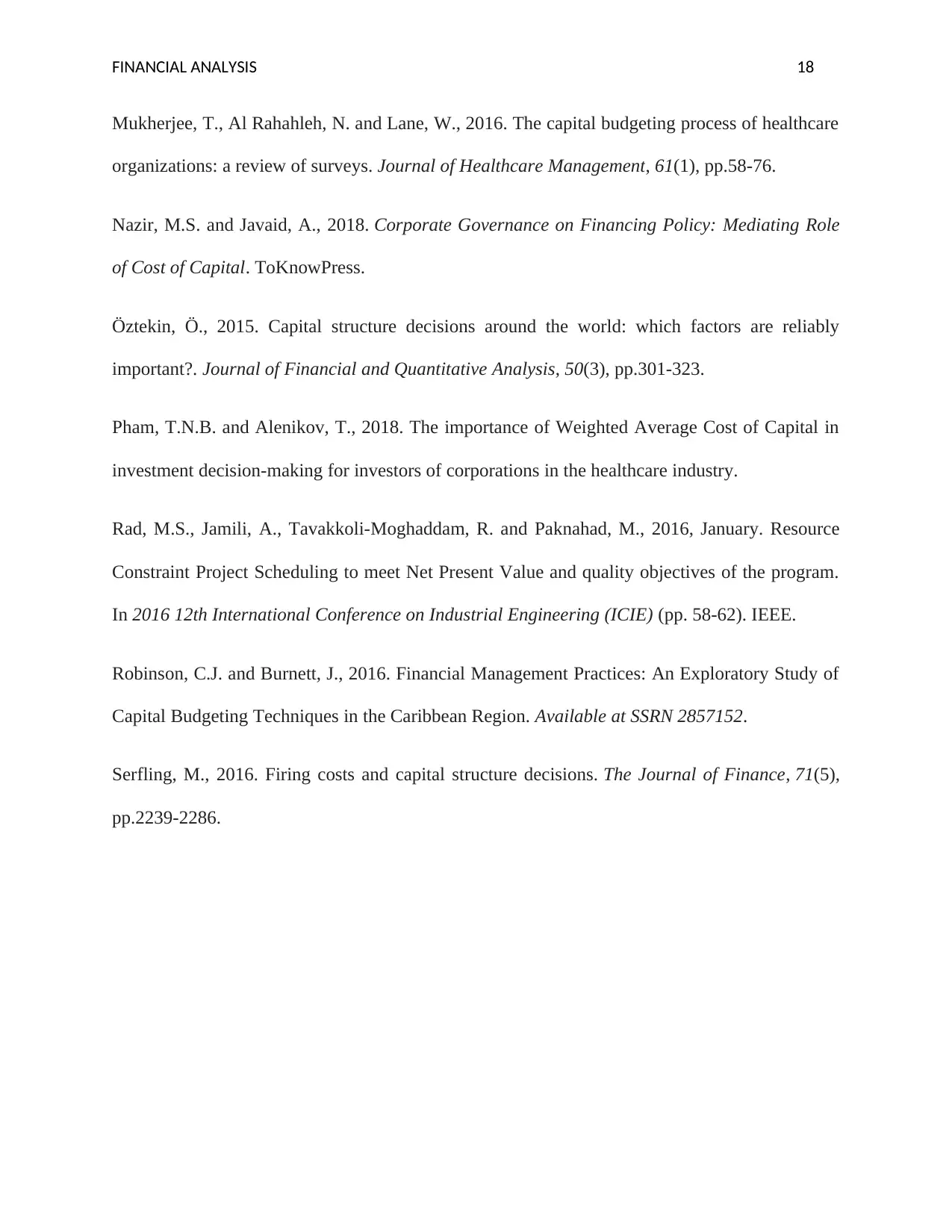
FINANCIAL ANALYSIS 18
Mukherjee, T., Al Rahahleh, N. and Lane, W., 2016. The capital budgeting process of healthcare
organizations: a review of surveys. Journal of Healthcare Management, 61(1), pp.58-76.
Nazir, M.S. and Javaid, A., 2018. Corporate Governance on Financing Policy: Mediating Role
of Cost of Capital. ToKnowPress.
Öztekin, Ö., 2015. Capital structure decisions around the world: which factors are reliably
important?. Journal of Financial and Quantitative Analysis, 50(3), pp.301-323.
Pham, T.N.B. and Alenikov, T., 2018. The importance of Weighted Average Cost of Capital in
investment decision-making for investors of corporations in the healthcare industry.
Rad, M.S., Jamili, A., Tavakkoli-Moghaddam, R. and Paknahad, M., 2016, January. Resource
Constraint Project Scheduling to meet Net Present Value and quality objectives of the program.
In 2016 12th International Conference on Industrial Engineering (ICIE) (pp. 58-62). IEEE.
Robinson, C.J. and Burnett, J., 2016. Financial Management Practices: An Exploratory Study of
Capital Budgeting Techniques in the Caribbean Region. Available at SSRN 2857152.
Serfling, M., 2016. Firing costs and capital structure decisions. The Journal of Finance, 71(5),
pp.2239-2286.
Mukherjee, T., Al Rahahleh, N. and Lane, W., 2016. The capital budgeting process of healthcare
organizations: a review of surveys. Journal of Healthcare Management, 61(1), pp.58-76.
Nazir, M.S. and Javaid, A., 2018. Corporate Governance on Financing Policy: Mediating Role
of Cost of Capital. ToKnowPress.
Öztekin, Ö., 2015. Capital structure decisions around the world: which factors are reliably
important?. Journal of Financial and Quantitative Analysis, 50(3), pp.301-323.
Pham, T.N.B. and Alenikov, T., 2018. The importance of Weighted Average Cost of Capital in
investment decision-making for investors of corporations in the healthcare industry.
Rad, M.S., Jamili, A., Tavakkoli-Moghaddam, R. and Paknahad, M., 2016, January. Resource
Constraint Project Scheduling to meet Net Present Value and quality objectives of the program.
In 2016 12th International Conference on Industrial Engineering (ICIE) (pp. 58-62). IEEE.
Robinson, C.J. and Burnett, J., 2016. Financial Management Practices: An Exploratory Study of
Capital Budgeting Techniques in the Caribbean Region. Available at SSRN 2857152.
Serfling, M., 2016. Firing costs and capital structure decisions. The Journal of Finance, 71(5),
pp.2239-2286.
Paraphrase This Document
Need a fresh take? Get an instant paraphrase of this document with our AI Paraphraser

FINANCIAL ANALYSIS 19
Appendix
Project Aspire Years
0 1 2 3 4 5 6
Plant and
machinery 2250000
Scrap value 375000
Cash Inflows 650000 698750 751156 807493 868055
Variable costs -27000 -28823 -30768 -32845 -35062
Earnings before
interest and tax 623000 669928 720388 774648 1207993
Taxes @ 20% 0 124600 133986 144078 154930 241599
Capital Allowance 600000 390000 345000 300000 240000
Tax benefits 0 120000 78000 69000 60000 48000
Total cash flow 623000 665328 664403 699570 1113063
-
193599
Working note
Cash Inflows 650000 698750
751156.2
5
807492.968
8
868054.
9
Growth Rate 7.50% 7.50% 7.50% 7.50%
Variable costs
Variable costs -27000 -28823 -30768 -32845 -35062
6.75% 6.75% 6.75% 6.75%
Calculation of Net
present Value
Years Cash
flows
Discountin
g Factor @
10%
NPV
0 -2250000 1.00 -2250000
1 623000 0.91 566930
2 665328 0.83 552222
3 664403 0.75 498302
4 699570 0.68 475708
5 1113063 0.62 690099
6 -193599 0.56 -108415
Net Present Value 424846
Appendix
Project Aspire Years
0 1 2 3 4 5 6
Plant and
machinery 2250000
Scrap value 375000
Cash Inflows 650000 698750 751156 807493 868055
Variable costs -27000 -28823 -30768 -32845 -35062
Earnings before
interest and tax 623000 669928 720388 774648 1207993
Taxes @ 20% 0 124600 133986 144078 154930 241599
Capital Allowance 600000 390000 345000 300000 240000
Tax benefits 0 120000 78000 69000 60000 48000
Total cash flow 623000 665328 664403 699570 1113063
-
193599
Working note
Cash Inflows 650000 698750
751156.2
5
807492.968
8
868054.
9
Growth Rate 7.50% 7.50% 7.50% 7.50%
Variable costs
Variable costs -27000 -28823 -30768 -32845 -35062
6.75% 6.75% 6.75% 6.75%
Calculation of Net
present Value
Years Cash
flows
Discountin
g Factor @
10%
NPV
0 -2250000 1.00 -2250000
1 623000 0.91 566930
2 665328 0.83 552222
3 664403 0.75 498302
4 699570 0.68 475708
5 1113063 0.62 690099
6 -193599 0.56 -108415
Net Present Value 424846

FINANCIAL ANALYSIS 20
Calculation of IRR Cash
flows
Calculation
of Payback
Period
Cash
flows
Cumulative
Cash flows
-2250000 -2250000 -2250000
623000 623000 -1627000
665328 665328 -961673
664403 664403 -297270
699570 699570 402301
1113063 1113063 1515364
-193599 -193599 1321766
IRR 16.8% 3.42
Project Wolf Years
0 1 2 3 4 5 6
Plant and machinery 2250000
Scrap value 0
Cash Inflows 955000 955000 955000 955000 955000
Material costs -14400 -15480 -16641 -17889 -19231
Other Expenses 18000 16650 15401 14246 13178
Foregone Rental Income -75000 -75000 -75000 -75000 -75000
Earnings before interest
and tax 847600 847870 847958 847865 847592
Taxes @ 20% 0 169520 169574 169592 169573 169518
Total cashflow 847600 678350 678384 678273 678019 -169518
Working note
Other expense 18000 16650 15401 14246 13178
Declining Rate 7.50% 7.50% 7.50% 7.50%
Variable costs
Variable costs -14400 -15480 -16641 -17889 -19231
7.50% 7.50% 7.50% 7.50%
Calculation of IRR Cash
flows
Calculation
of Payback
Period
Cash
flows
Cumulative
Cash flows
-2250000 -2250000 -2250000
623000 623000 -1627000
665328 665328 -961673
664403 664403 -297270
699570 699570 402301
1113063 1113063 1515364
-193599 -193599 1321766
IRR 16.8% 3.42
Project Wolf Years
0 1 2 3 4 5 6
Plant and machinery 2250000
Scrap value 0
Cash Inflows 955000 955000 955000 955000 955000
Material costs -14400 -15480 -16641 -17889 -19231
Other Expenses 18000 16650 15401 14246 13178
Foregone Rental Income -75000 -75000 -75000 -75000 -75000
Earnings before interest
and tax 847600 847870 847958 847865 847592
Taxes @ 20% 0 169520 169574 169592 169573 169518
Total cashflow 847600 678350 678384 678273 678019 -169518
Working note
Other expense 18000 16650 15401 14246 13178
Declining Rate 7.50% 7.50% 7.50% 7.50%
Variable costs
Variable costs -14400 -15480 -16641 -17889 -19231
7.50% 7.50% 7.50% 7.50%

FINANCIAL ANALYSIS 21
Calculation of Net
present Value
Years Cash
flows
Discountin
g Factor @
10%
NPV
0
-
225000
0 1.00
-
225000
0
1 847600 0.91 771316
2 678350 0.83 563031
3 678384 0.75 508788
4 678273 0.68 461226
5 678019 0.62 420372
6
-
169518 0.56 -94930
Net Present Value 379801
Calculation of IRR Cash
flows
Calculatio
n of
Payback
Period
Cash
flows
Cumulativ
e Cash
flows
-2250000
-
225000
0 -2250000
847600 847600 -1402400
678350 678350 -724050
678384 678384 -45666
678273 678273 632607
678019 678019 1310626
-169518
-
169518 1141107
IRR 17.0% 3.07
Calculation of Net
present Value
Years Cash
flows
Discountin
g Factor @
10%
NPV
0
-
225000
0 1.00
-
225000
0
1 847600 0.91 771316
2 678350 0.83 563031
3 678384 0.75 508788
4 678273 0.68 461226
5 678019 0.62 420372
6
-
169518 0.56 -94930
Net Present Value 379801
Calculation of IRR Cash
flows
Calculatio
n of
Payback
Period
Cash
flows
Cumulativ
e Cash
flows
-2250000
-
225000
0 -2250000
847600 847600 -1402400
678350 678350 -724050
678384 678384 -45666
678273 678273 632607
678019 678019 1310626
-169518
-
169518 1141107
IRR 17.0% 3.07
1 out of 22
Related Documents
Your All-in-One AI-Powered Toolkit for Academic Success.
+13062052269
info@desklib.com
Available 24*7 on WhatsApp / Email
![[object Object]](/_next/static/media/star-bottom.7253800d.svg)
Unlock your academic potential
© 2024 | Zucol Services PVT LTD | All rights reserved.





